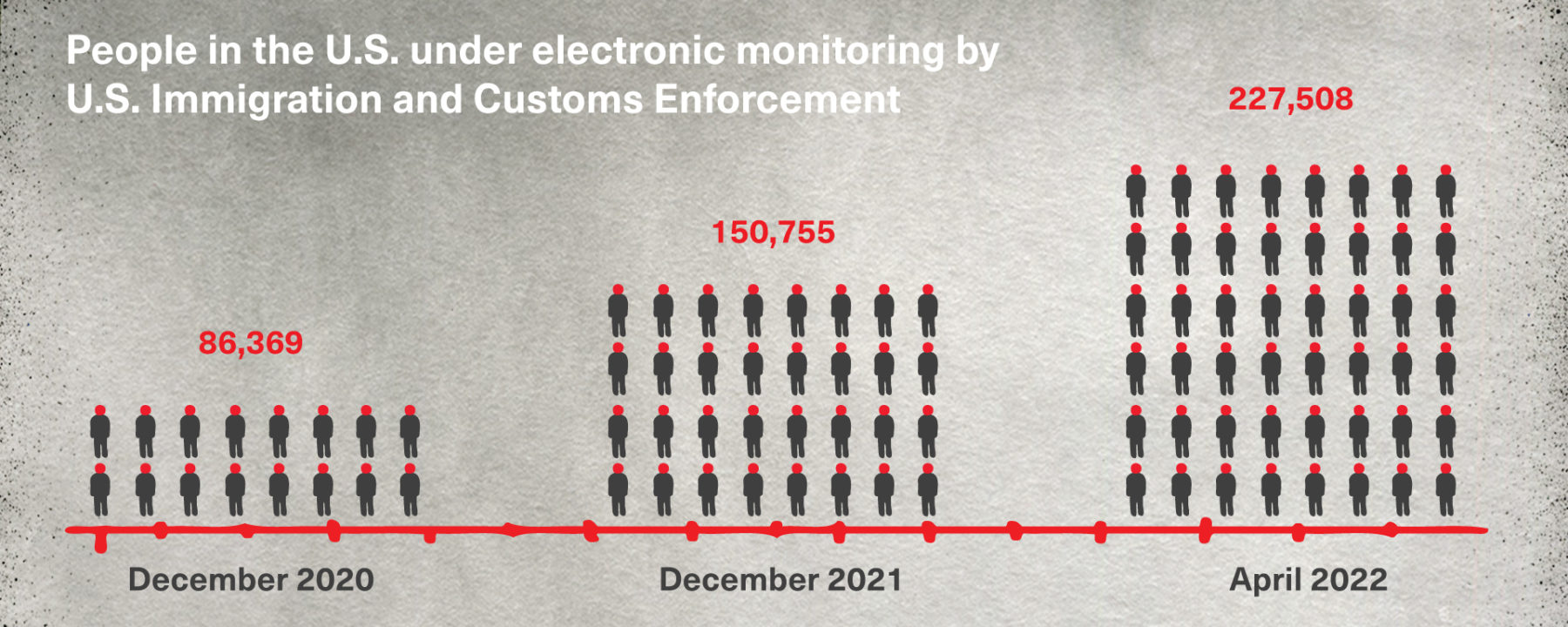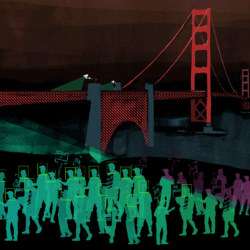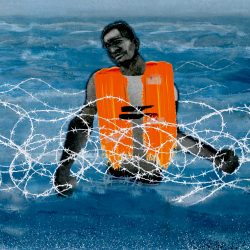
Ann Kiernan
‘I felt like I was a prisoner’: The rapid rise of US immigration authorities’ electronic surveillance programs
- Illustrations by Ann Kiernan
Ssemanda felt free, for a moment.
It was August 2020, and the young political asylum seeker from Uganda was about to walk out of the Imperial Regional Detention Facility in California, just north of the U.S.-Mexico border. Ssemanda eagerly took a shower and changed into a fresh set of clothes. He felt “joy and happiness” — a sensation that he was, at long last, “finally moving out.”
But then he saw the device: a black GPS-enabled electronic ankle monitor. Before Ssemanda was released, an employee at the detention center fastened the electronic bracelet around his leg, handed him a charger, and barked a few instructions at him about the device, a common tool used by U.S. Immigration and Customs Enforcement (ICE) to monitor migrants awaiting their immigration hearings. “If anything goes wrong, you’re coming back to the detention center,” Ssemanda recalled him saying. With the bulky monitor newly wrapped around his ankle, Ssemanda felt his mood lurch back to distress.
“That is where my happiness stopped. That is the moment I regretted. I didn’t get that happiness of someone being free.”
The monitor gave Ssemanda his first scare a few days later when he flew to his new home on the East Coast. A few hours into the flight, his bracelet began beeping loudly, indicating that it was low on batteries. But Ssemanda had placed the charger in a checked bag. Mortified, he ran to the plane’s bathroom and hid there every time the device blared. “I was so uncomfortable, I didn’t want to attract people’s attention,” he recalled. When the plane landed, he couldn’t shake the worry that he had done something wrong, and immigration agents were on their way to scoop him up and put him back in detention.
“You feel like at any time, someone can come and grab you,” he told me. “You feel you cannot move freely. Like you are carrying a burden you can’t expose. I felt like I was a prisoner, inside another prison.”

Across the U.S., a surveillance system tracking the movements of tens of thousands of people seeking refuge or permanent residency in the U.S. is quietly but quickly expanding. The ankle monitor attached to Ssemanda’s leg is one piece of a program run by federal immigration officials known as “Alternatives to Detention,” (ATD) which places people in deportation proceedings and awaiting court hearings under electronic surveillance while their cases are pending.
Authorities monitor ATD enrollees through three primary methods: the GPS ankle device; a telephonic reporting system that facilitates participant check-ins using voice-recognition technology; and an increasingly common mobile check-in app that uses facial recognition software. Although the program launched in 2004, the number of migrants placed under ATD has skyrocketed under the Biden administration. When President Joe Biden took office in January 2021, less than 90,000 people were in the program. Now, more than a quarter million people, including asylum seekers like Ssemanda, are enrolled in the digital surveillance system.

This is due almost exclusively to the adoption of the mobile facial recognition app, SmartLINK. Just a year ago, one-third of all immigrants under digital surveillance were on the app; now, it accounts for 75% of enrollees. It’s unclear how many of these people are asylum seekers. ICE acknowledged a public records request that Coda sent seeking data on this question, but the agency had not fulfilled our request at the time of publication. What we do know is that anyone on ATD — asylum seeker or not — can expect to spend more than a year under the government’s digital eye. The average person is enrolled in the program for 421 days. This trend shows no sign of slowing down. The Biden administration has requested $527 million in funding for ATD in the 2023 fiscal year, an $87 million — or 20% — increase from its 2022 budget. The company overseeing the program in partnership with ICE has the ability to monitor up to 400,000 people in its current contract, according to Axios.
ICE spokespeople and officials at the Department of Homeland Security espouse the technology-driven approach to immigration enforcement as a kinder, gentler alternative to physical detention. But for people like Ssemanda, there was nothing humane or gentle about the ankle monitor. It merely shifted the boundaries of incarceration from cell to self.
“You feel you’re in prison again,” he said, likening the bracelet to an electronic cage that hovered overhead as he tried to carve out a new life in the U.S. It was an unwieldy symbol of his tenuous place in America, a subtle threat.
The monitor also brought up the sensation of being tracked in the country he fled, Uganda, where he was kidnapped, beaten, and tortured for his advocacy against the government, mobilizing youth in support of democracy efforts. “I left my country because of certain kinds of problems I had, and then when I came here, I couldn’t believe that I’m the one having that bracelet. That I was facing this kind of situation in the U.S.”
“If they had told me that we are setting you out on the condition that you are going to have a bracelet, I would have told them, please, keep me inside,” he said. When Ssemanda caught up with friends who were still in detention, he would advise them to stay. “I told them, please don’t waste time moving out,” he added. “This bracelet, you won’t feel well. I’m outside, but I’m not okay.” The stigma attached to the ankle monitor, the anxiety produced by its beeps, the sensation that the government could be tracking his movements — it all weighed on him to the point he cried “tears of joy” when it finally came off after three months on his body, thanks to the successful appeals of his immigration attorneys.

Loren Elliot / AFP via Getty Images
Ssemanda’s experiences are consistent with findings from a 2021 report published by the immigrant rights groups Freedom for Immigrants, the Immigrant Defense Project and the Benjamin N. Cardozo School of Law. The study cited surveys of approximately 150 immigrants placed under electronic ankle monitoring, in which 90% of respondents said the device negatively affected their mental health, causing psychological harms ranging from anxiety to sleep disruption, social isolation, and depression. Twelve percent of respondents said the shackle led them to thoughts of suicide. Nearly 40% said they believed the monitor’s mental health impact was permanent.
Karlyn Kurichety, an attorney with the border-based migrant rights group Al Otro Lado, which provides legal support to asylum seekers, said ATD’s surveillance system has been “retraumatizing” for clients who have experienced government repression overseas.
“We work with a lot of clients who are survivors of torture,” she said. “And oftentimes government surveillance in their country of origin was a part of the persecution or was something that led up to severe acts of violence against them.” Kurichety added: “[ATD] really serves no purpose other than just to harass and intimidate survivors, often survivors of violence who are exercising their legal right to seek asylum in this country.”
Roberto, a 36-year-old political asylum seeker from Latin America, said the monitor made him feel as though he was still in confinement. “That has a big impact and even more if you are running away from places where you weren’t free,” explained Roberto, who asked to withhold his country and real name due his ongoing asylum case. “You come from political persecution, running away from people who want to hurt you, from a system that wants to hurt you. And come here looking for help and shelter.”
He added: “The U.S. has been a role model for a lot of countries and if these solutions ended up in the hands of the dictatorships we are running away from, the impact would be truly negative. Imagine you are in a dictatorship and they put this ankle monitor on you for being opposed to the government. So I think the U.S. should think about this. Using these technologies and giving the idea of using them to other governments is a threat.”
The ankle monitor was stressful and psychologically burdensome for Roberto and even seemed to rub off on his young daughter, who recently told him she didn’t like the U.S. “I asked her why, and she answered that she didn’t like the monitor,” he said. “Even though she is 4, she can perceive that it is negative.”
The latest iteration of ATD has shifted from ankle to face, thanks to SmartLINK, the mobile phone app that people are required to download and use for periodic check-ins with ICE. During check-ins, ATD enrollees must upload a photo of themselves, which is then matched to an existing picture taken during their program enrollment using facial recognition technology. The app also captures the GPS data of participants during check-ins to confirm their location.
SmartLINK is expanding the boundaries of ICE’s digital monitoring system, this time from a wearable device to something that is less visible but ever-more ubiquitous. This expansion is taking place despite mounting concerns about the program’s negative effects on enrollees, and federal officials’ failure to provide adequate information about SmartLINK’s data collection policies and privacy safeguards. This is no small matter, especially given SmartLINK’s corporate origins. Along with the rest of ATD, SmartLINK is run by B.I. Incorporated, a cattle tracking-turned-prison technology firm and a subsidiary of the private prison company the GEO Group, which operates more than 100 state and federal prisons, detention centers, and other facilities nationwide.
Since the ATD’s inception during the Bush era, B.I. has contracted with ICE to provide its surveillance technology. ICE’s most recent contract with B.I., signed in 2020, allocates $2.2 billion to the company over a five-year period. Critics argue that B.I.’s partnership with ICE creates a financial incentive for the expansion of mass immigrant surveillance. They also say that it contradicts the government’s argument that the program is a genuine “alternative” to detention, given that the company earning the government contract for ATD technology is a subsidiary of one of the nation’s primary for-profit detention providers.
Jacinta Gonzalez, senior campaign director for Mijente, a group that campaigns against the use of surveillance in immigration enforcement, underlined this point. “To now have the same companies that have been in charge of private detention centers basically shapeshift and now pretend that they’re the market for alternatives to detention, and promote that in a way that is really kind of expanding the surveillance web that is in the power and in the hands of ICE, is incredibly concerning,” she said. “It is marketing by a company that is just trying to continue to make a profit off of human suffering.”
“We don’t really see these as a true alternative or really any alternative at all because they are still, in essence, punitive. They’re surveilling people and restricting their liberty,” explained Layla Razavi, interim co-executive director at the nonprofit Freedom for Immigrants. She added: “Alternatives to detention is a phrase that first started being used over a decade ago by advocates to talk about what a vision would look like for a world in which we didn’t have immigration detention centers, but instead were welcoming in supporting newly arriving immigrants into this country. And that phrase, as it began to gain steam among the immigrants rights movement and advocates, started to become co-opted by the very private prison companies that were advocating and lobbying the federal government directly for increased resources.”
There has been some pushback to the ATD’s rollout in Washington — more than two-dozen House Democrats recently sent a letter to DHS Secretary Alejandro Mayorkas, expressing concern with the program. But the general attitude within the administration seems to be enthusiastic about the tech, said Rebekah Wolf, policy counsel at the D.C.-based nonprofit American Immigration Council. “There is certainly a sense in the administration that there is no appetite for release without some form of surveillance, and so that’s why they are so dramatically increasing these programs. The impression is that this is the only way that they could ever make gains or move forward on some of their promises in reducing detention and restoring asylum at the border.”

Some speculate that the government has turned to SmartLINK because it is vastly more scalable — anyone with a smartphone can download the application and use it — and likely cheaper to implement than placing tens of thousands of people on a GPS tracking ankle bracelet. Julie Mao, deputy director of the immigrant rights legal firm Just Futures Law, which focuses on the intersection of immigration and technology, recalled working as an immigration attorney in Louisiana in 2014 amid an increase in border crossings. “That’s when we really saw an explosion of ankle shackles happen,” she explained. “I think we’re at a similar inflection point now.” Mao added: “I suspect they are reaching their supply limit for ankle shackles. The logistics of shipping ankle shackles back to the border, ankle shackles breaking, needing to resupply. That is costly and difficult compared to just downloading an app.”
Politically, it’s not hard to see why this would be an appealing approach to Biden administration officials, as Republicans’ bullishness on immigration has long left Democrats on the defensive. Shifting the geography of detention to the digital sphere puts liberal politicians in a different place on the continuum of immigration enforcement, giving them a new narrative, one in which they can fend off attacks from the right of being “soft” on the border while also claiming to take a more “humane” approach than their Republican counterparts.
Surveillance technology is inherently difficult to visualize and illustrate. “It effectively depoliticizes the technology because people can’t get it in their heads,” said Austin Kocher, an assistant professor focusing on U.S. immigration enforcement with the Transactional Records Access Clearinghouse (TRAC), a research center based at Syracuse University. He continued: “Whereas the Republicans want very simple ideas and very simple concrete material things that are very easy to point to and mobilize around. Democrats are much more effective at sort of depoliticizing these technologies through their diffusion in society.”
The government has made little information publicly available about SmartLINK’s privacy and data collection policies. Since B.I. is a private company, it is not subject to federal public records laws.
Advocates have tried, and failed, to get more details about SmartLINK from the federal government. In September 2021, a coalition of immigrant’s rights groups filed a Freedom of Information Act (FOIA) request with ICE seeking information “pertaining to the collection of data from the SmartLINK application, the retention, sharing, and use of such data, and the nature of monitoring through the application.” ICE never responded, and last month the organizations sued the agency under FOIA to try to obtain the information.
The lawsuit alleges that BI’s privacy policy for SmartLINK “allows for extremely broad collection of data,” and points to language in the policy, which states that the app collects “individuals’ names, contact information, social security number;” “information such as facial images from photos and voice samples from audio files;” “[g]eolocation data about physical movements and location;” and “App activity and other usage activity such as Internet and similar network activity.”
Julie Mao of Just Futures Law, one of the groups that submitted the records request and is involved in the FOIA litigation, said she and other advocates are concerned that ICE “has not provided oversight over the contracting company that it’s using.” The agency and BI, she added, “are hiding the ball on what data is being collected on individuals.” In addition to Mao’s concerns about the app’s data retention and collection policies, there is a lack of clarity about whether the data collected via SmartLINK is accessible to other government agencies.
When Coda inquired about these practices with B.I., the company referred us to ICE. A spokesperson for the agency did not address questions about the app’s data collection, retention, and sharing policies, but stated that ICE is “committed to protecting privacy rights, and civil rights and liberties of all participants within the Alternatives to Detention Program.”
According to a fact sheet about ATD on GEO’s website, “All data collected through [electronic monitoring] is the property of ICE, not GEO or BI. Any biometric information collected through technology tools resides solely on the participant’s electronic device and is not transferred, transmitted or downloaded to any other device or system.” The company cites an excerpt of B.I.’s contract with ICE, which stipulates that “the Contractor shall not retain, use, sell, disseminate, or dispose of any government data/records or deliverables.” It also states that B.I. “complies with all federal privacy laws” but this doesn’t mean much in the U.S., where there is no comprehensive federal privacy legislation. One page on the website promises that B.I. “does not track individuals, collect background data, or conduct any ‘surveillance’ activities,” while another limits this pledge solely to “‘surveillance’ activities.”
In 2019, ICE told the Congressional Research Service that SmartLINK does not monitor SmartLINK’s enrollees’ locations through their phones “as a GPS monitor would” and only gathers location data during participants’ check-ins. But Mao noted that the application has the technical capability to monitor enrollees’ locations in real-time. People in ATD have expressed fears that the app is monitoring their whereabouts beyond the designated check-ins.
“Our concern is that this program is being used as this mass surveillance control system for immigrants,” she said.
The privacy policy for SmartLINK offers a more detailed picture than what appears on the GEO website, including a long list of data that the app does collect — location data, photos and videos taken through the app, audio files, voice samples, and audio messages sent through the app, and information about a user’s device, including IP addresses and other unique identifiers. The policy acknowledges that third parties “may use automatic information collection technologies to collect information about you or your device.”
When Coda Story contacted B.I. for comment on the above policy, the company confirmed that the March 2022 document is up to date. Mao said the policy “confirms that BI is collecting a tremendous amount of sensitive data through its mobile application and sharing that information with third parties.” This is no small matter — independent research has shown that when this kind of data is available to third parties, it can be incredibly easy for anyone, from digital marketers to government agencies, to pinpoint a person’s identity and gather an enormous amount of information about their behavior.
And ICE already has access to a bulk of Americans’ data. An eye-opening investigation from the Georgetown Law Center on Privacy and Technology recently found that the agency has built a sweeping national surveillance apparatus that has the ability to spy on most people in the U.S. by accessing state and local government databases and purchasing data from private data brokers, which package and sell peoples’ data for profit.
Like most technologies, SmartLINK doesn’t always work like it should. Problems like service outages or a phone falling into the toilet, that would normally just be cause for frustration, can trigger a deep sense of dread for enrollees, as can simple malfunctions. Juan, a 24-year-old asylum seeker from Central America, has been on SmartLINK for the last year. Before that, he was placed on an ankle monitor. One afternoon, he attempted to submit a photo of himself for his weekly check-in, but he couldn’t tell if the upload had successfully gone through. Shortly after the scheduled check-in, an employee overseeing the check-ins with B.I. called Juan and told him to upload a new photo on the app, which Juan did.

A few minutes later, Juan got another call, this time from a different employee. This person had a harsher tone, Juan recalled, asking why he didn’t take a picture, and telling him that his failure could result in a penalty. The remark upset Juan, who told him he intended to call his lawyer. “You can talk to your lawyer, the president, it doesn’t matter to me,” the employee replied. Juan instantly worried that a technical mistake made with the app could lead to serious consequences and even his possible re-detention. So, he explained, “I had to put my head down and do as he said.”
He added: “Sometimes I asked myself, why is there all this monitoring? So many photos, so much information. I think this is a question that not just me, but everyone in the program is asking. It makes no sense. As migrants, they act like we are criminals, risks to the community. But we are not.”
Juan is not the only person for whom SmartLINK’s technology has proven stressful. Some users have taken to expressing their frustration with the app’s functionality on the App Store, where SmartLINK has a 2.8 rating. In reviews, multiple users state they had trouble logging into the app and uploading photos and location data. “When I try to log in, I have to make 3 attempts every time,” one wrote. “Then today I never got the alert that I had a check-in. This is a pretty major flaw when your freedom relies on it.” (GEO disputes claims that the app routinely malfunctions, writing that “an average of 88.4% of SmartLINK check-ins were completed successfully over the last five years.”)
A report published this week by a coalition of immigrant’s rights groups found the app’s check-in process is emotionally taxing for enrollees and fears of constant surveillance trigger anxiety. The study published testimonials from 11 people on ATD. One respondent, who came to the U.S. from South Africa, said “SmartLINK reminds me of Apartheid in my country. The constant harassment by police everyday because you’re a member of a certain political party.”
Carlos, 39, has been on SmartLINK for about a year. He described the app as “the same” as the ankle monitor. “Physically, it’s different. But it’s the same uncertainty, worry. The only thing that changes is the system.” Carlos believes ATD’s surveillance has affected the psychological well-being of his entire family, including his three teenage daughters. He describes it as a “shadow” that hangs over the family. “Every time I get a call from an unknown number and they see it, they think that it’s from ICE asking me where I am. It’s the same fear.”
When it comes to migration, the turn to technology as the more “humane” way to enforce policy has followed a predictable narrative pattern. Criticisms arise with the status quo; new tech crops up to address said concerns and save the government money, and then the process repeats itself.
Each fork in the road to a digitally-enforced border and immigration system, however, beckons unintended consequences. Technologies first used on immigrants become susceptible to “mission creep” and later expand to other people and areas. “We know that oftentimes surveillance technologies are first used on marginalized populations at the border, against immigrant communities as a means of surveillance and then spreads to other places as well,” said Saira Hussain, a staff attorney at the Electronic Frontier Foundation, a nonprofit focused on digital privacy and surveillance.
Last year, Coda reported on communities that are subjected to constant technological monitoring along the U.S.-Mexico border. A resident of a town in Southern Arizona enveloped by surveillance technology said the area’s digital infrastructure made her feel “paranoid” about privacy and government intrusion and influenced how she moved around town. During the 2020 protests held in response to the police killing of George Floyd, CBP deployed drones to more than a dozen cities across the U.S., which logged hundreds of hours of video footage in a digital network managed by the Department of Homeland Security and accessible to local police departments.
Mario Perez, whose experience in detention led him to become an immigration organizer and activist, was on SmartLINK for three years. He began to worry about the data the app collected on him after learning of an ICE raid at a poultry plant in Mississippi. Nearly 700 people were arrested, thanks in part to data that authorities had captured from workers’ GPS monitors. Headlines about the raid made Mario wonder about the kind of access immigration officials had to the data on his phone. “It just seems like it’s a mess,” he said.
“With reports about general surveillance in the U.S. and general American citizens being surveilled by ICE, if this isn’t worrying everybody — I don’t care if you are an immigrant or under one of these programs — this is just getting started from what we’re seeing. We don’t know far this is going to be taken. It’s really scary.”
The story you just read is a small piece of a complex and an ever-changing storyline that Coda covers relentlessly and with singular focus. But we can’t do it without your help. Show your support for journalism that stays on the story by becoming a member today. Coda Story is a 501(c)3 U.S. non-profit. Your contribution to Coda Story is tax deductible.
















